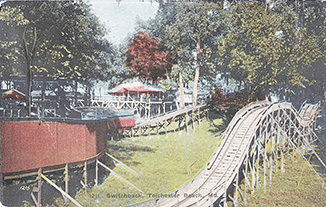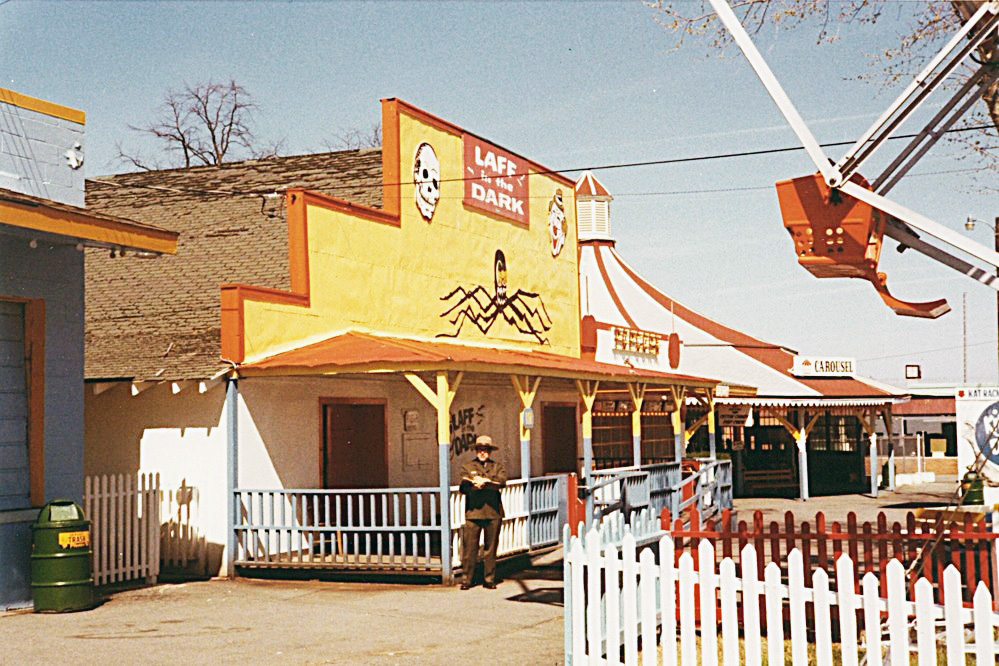
Maryland Amusement Parks
Part II
Richard D. L Fulton
Amusement parks and their subgenre, theme parks, trace their origins back to the 1800s, and many more modern parks continue to thrive exceedingly well today. The difference between an amusement park and a theme park is that amusement parks provide general entertainment, while theme parks ten d to focus more on storytelling. For example, Glen Echo Park would be classified as an amusement park, while the Enchanted Forest (Ellicott City, Maryland) would be classified as a theme park.
There was no shortage of amusement parks and theme parks in Maryland. Some claim that there were dozens over the course of some 130 years, several of which still exist today. However, only a select few could be discussed in Part I and Part II of Maryland Amusement Parks due to space constraints.
Tolchester Beach Amusement Park
The Tolchester Beach Amusement Park, located north of Rock Hall in Kent County, operated from 1877 up through 1962, when it was closed, according to the March 27, 2014, edition of The County News.
The “park” was founded by the Tolchester Steamboat Company on a 10-acre site to capitalize in transporting interested beachgoers to the beach at Tolchester. Steamboats operated from “from Baltimore and other places,” delivering beachgoers to the Tolchester shoreline.
Over the span of time, the beach park had evolved into a full-blown amusement park, including a hotel, pavilion, a good many various amusement rides, and other attractions, according to the Maryland Historic Trust.
By the time of Tolchester Beach Amusement Park’s closure in 1962, it had grown to encompass some 150-plus acres, which saw as many as 20,000 visitors per weekend.
At the height of its development as an amusement park, journalist Lauren Ober had noted in “Remembering the Heyday of a Chesapeake Bay AmusementPark (WAMU, May 16, 2014),” that, “Basically, it was… the ‘Ocean City’ of its day.”
Attractions offered had grown from those of merely being a beach park to include a merry-go-round, a miniature steam train, a miniature golf course, a shooting gallery, bumper cars, a dance hall, a roller-skating rink, a bowling alley, a bandstand, a penny arcade, and souvenir stands.
The park was closed in 1962, principally due to the construction of the Chesapeake Bay Bridge, which had made it much easier for the public to gain access to the ocean beaches.
Marshall Hall Amusement Park
The Marshall Hall Amusement Park was in Marshall Hall, Charles County, on the Potomac River, across the river from President George Washington’s homesite on the Virginia side of the river.
The site was originally a plantation that had been founded by Thomas Marshall in the 1700s, and remained in agricultural use, subsequently having served as a private park until 1889 when the land was acquired by the Mount Vernon and Marshall Hall Steamboat Company, who then commenced to develop the site as a tourist attraction.
The steamboat company established a small amusement park in the 1920s (the site was used for family and group gatherings and picnicking, beginning back in the late 1880s). In 1954, the park was purchased by another touring boat operation known as the Wilson Line, which further enhanced and added attractions well into the 1960s. Although the park could be accessed by land, apparently most park visitors preferred to take the ferry boats to the site.
In 1949, hundreds of slot machines were permitted by the state to be included among the park’s attractions, which continued to be permitted until 1968, while in 1958, a snack bar and a cocktail bar were then added.
The park ultimately offered a wide range of amusements and rides. Attractions offered grew from that of merely being a Potomac River Park to including an ice rink and a swimming pool, along with other attractions, which included a carousel, ferris wheel, rollercoaster, bumper cars, a shooting gallery, a haunted house, and a sky-lift. The park was closed in 1980, when the National Park Service acquired the site and removed the amusement park, thereby then incorporating the land into Piscataway Park.
The Enchanted Forest (theme) Park
The Enchanted Forest (theme) Park was located in Ellicott City, Howard County, and was created on property owned by Howard Harrison, who, with the help of family members and others, created the theme park.
The Howard family sold their Belgian Village Motel in East Baltimore to help pay for the park’s construction. Howard worked with a 10-person team to bring the proposed Enchanted Forest into a reality, according to Preservation Maryland.
An advertisement that appeared in the August 14, 1955, edition of The (Baltimore) Sun announced the premier opening of the park to take place at 10:00 a.m. on August 15, further noting, “This is the adventure your entire family will never forget.”
In another advertisement placed in the September 1955 edition of the newspaper, the park was proclaimed as having been “Maryland’s answer to Disneyland.”
The park featured life-sized statues and buildings, as well as living costumed characters from various fairytales and children’s stories. The park provided around 20 storybook attractions, and after its grand opening, later added an Alice in Wonderland teacup ride, a “Little Toot” boat ride, and a Jungle Safari ride in Land Rover-type vehicles.
The park was permanently closed in 1989 due to competition from other area amusement parks and diminishing interest in the park’s “low-tech” attractions. It was sold in 1988 for $4.5 million to JHP Development. However, the park did continue to open various portions for birthday parties throughout 1994.
Commencing in 2004, the Clark’s Elioak Farm, of Ellicott City, was granted permission by the Kimco Realty Corporation, owners of the Enchanted Forest Shopping Center, to begin removing many of the attractions, which had still been sitting in the now-abandoned park, where the attractions had been undergoing restoration ever since.
Note: The Clark’s Elioak Farm still allows visitors to walk though their relocated Enchanted Forest. For more information, visit www.clarklandfarm.com.
Pen Mar Amusement Park
The Western Maryland Railroad created the Pen Mar Amusement Park in Cascade, Washington County, in 1877. Of course, the name comes from the fact that Pen Mar is located on the border between Maryland and Pennsylvania.
The park quickly became popular with residents of Washington, D.C., and Baltimore due to its idyllic mountain setting, offering a scenic escape from city life.
Pen Mar Park had many attractions, including a scenic lookout, rollercoaster, movie theatre, dance pavilion, picnic shelter, miniature train, photography studio, concession stand, carousel, penny arcade, a 450-seat dining hall, and a children’s playground, according to digitalmaryland.org.
According to an article that was published in the March 21, 1964, edition of The (Hagerstown) Daily Mail, the abandoned Pen Mar Amusement Park was still then owned by the Western Maryland Railroad, who was willing to sell the property for $35,000. The park grounds were still up for sale in 1974 after the property fell under the ownership of the Chessie System, The Daily Mail had reported on August 24 (1974).
The (Hagerstown) Daily Mail reported in the newspaper’s October 25, 1968, edition that the main reason the park closed: “Pen Mar Amusement Park declined during the 1930s when passenger trains lost favor, and family autos made it easy to find recreation elsewhere…”
The park finally closed in 1943. Washington County established a community park on the site of the old amusement park in 1977.

Tolchester Beach Amusement Park, 1922 postcard.

Marshall Hall Amusement Park, undated.

Willie the Whale and 3 Men in a Tub, Enchanted Forest, 1956.

Pen Mar Amusement Park, undated postcard.
